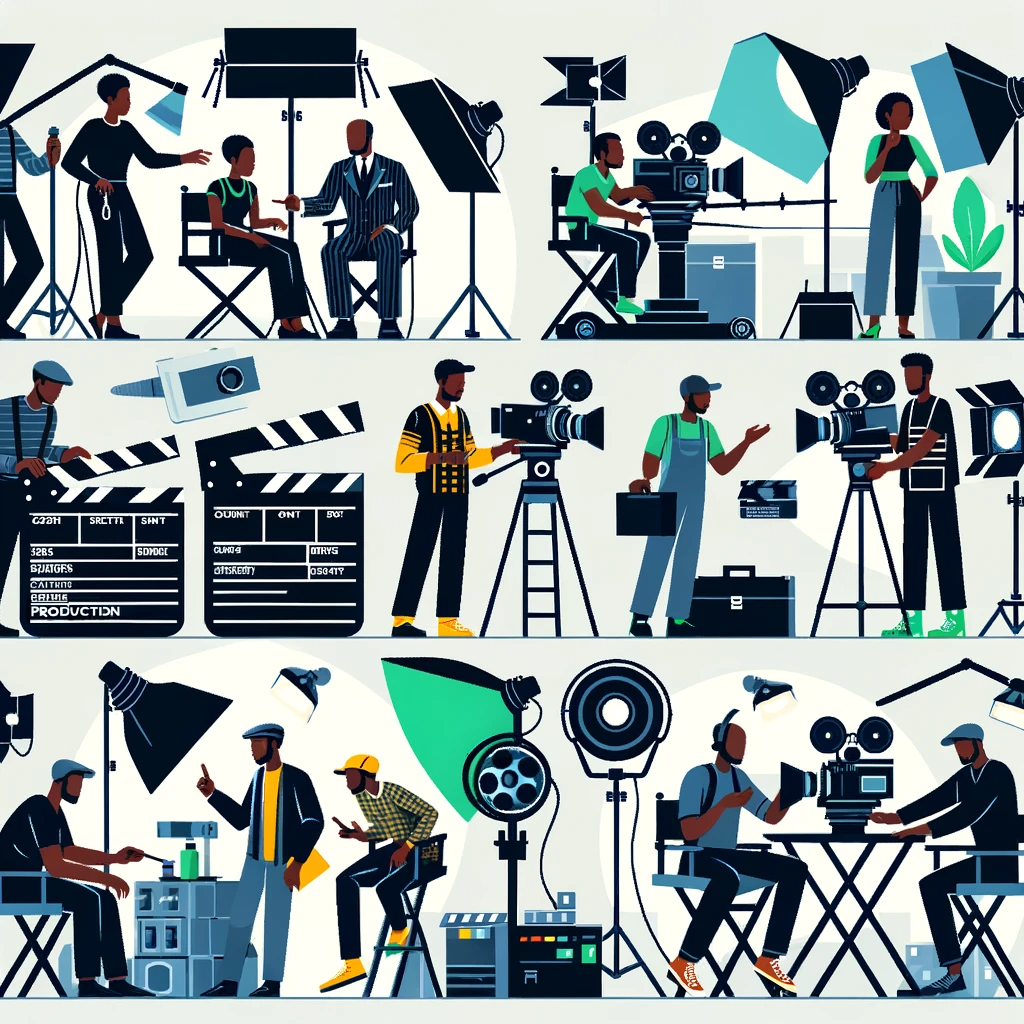Table of Contents
Every film you watch begins as an idea—but it’s on set, during production, that that idea becomes something real. The production phase is where all the planning meets execution: cameras roll, actors perform, lights shift, and the director’s vision begins to take shape frame by frame.
In this guide, we explore how Nigerian filmmakers navigate the realities of the production phase—from prepping scenes to capturing performances—while balancing budget, speed, and ambition.
What Is the Production Phase in Filmmaking?
The production phase is the active filming period where the movie is physically shot. It’s the busiest and most time-sensitive part of the process, often involving:
- A full cast and crew working long hours on location or in studios
- Tight daily schedules with back-to-back scenes
- Coordinated camera setups, lighting, sound, and performance
- Real-time problem solving under pressure
In Nollywood, where many projects must be completed on modest budgets and tight timelines, staying organized and focused is essential.
How Long Does Production Last?
The length of production depends on the size and scope of the film. For indie Nollywood films, it might last 2–3 weeks. For higher-budget or more ambitious projects, production can stretch to several months. The more detailed the pre-production, the smoother the production phase will run.
Prepping for a Smooth Shoot
Before the first “action” is ever called, filmmakers must put systems in place to avoid chaos on set. This includes:
Finalizing a Shooting Schedule
- The script is broken down scene by scene.
- Scenes are grouped by location, time of day, and cast availability.
- The team decides what order to shoot in for maximum efficiency.
Locking Down Key Elements
- Locations and permits secured
- Equipment rented and tested
- Vendors, transport, and catering arranged
Actor Preparation
- Table reads help actors understand the script and each other.
- Rehearsals lock in blocking (movement) and delivery.
Crew Coordination
- Department heads (cinematography, art, makeup, etc.) meet to align their work.
- Shot lists and storyboards are reviewed for clarity.
Solid preparation protects the creative process from logistical setbacks.

What Happens on Set Each Day?
Here’s a typical flow of a production day:
- Call Time: Crew arrives early to prep the set, lights, and camera.
- Blocking Rehearsals: Actors walk through the scene; camera and lighting adjust accordingly.
- Makeup & Wardrobe: Final touches are done.
- Rolling: The assistant director calls for silence. Sound rolls. Camera rolls. Director calls “action.”
- Multiple Takes: Scenes are shot from different angles to give editors more options later.
- Playback & Notes: Director reviews footage and gives feedback.
- Wrap: Once all shots are completed, gear is packed, and files are backed up.
This cycle repeats, day after day, until the entire film is shot.
Key Roles During Production
Director
- Guides the creative vision on set.
- Works closely with actors and cinematographer.
- Reviews takes and adjusts performance or framing as needed.
Cinematographer (DP)
- Controls the look of the film: lighting, framing, and camera movement.
Assistant Director (AD)
- Manages time, logistics, and set discipline.
- Keeps production on schedule.
Sound Mixer
- Records dialogue and ambient audio.
- Flags any audio issues that might need ADR later.
Script Supervisor
- Tracks continuity, dialogue accuracy, and scene coverage.
Everyone has a job—and when they work in sync, production flows smoothly.
Challenges of Production in Nigeria (and How to Handle Them)
Filming in Nigeria comes with unique hurdles:
- Unpredictable weather: Always have a backup indoor location if possible.
- Noise pollution: Scout quiet locations and use directional microphones.
- Power outages: Rent generators and manage fuel supply.
- Tight budgets: Stay on schedule to avoid costly overtime.
Creative thinking and strong leadership help crews overcome these challenges.
The Director’s Influence on Set
A director’s energy often sets the tone for the entire production. Strong directors:
- Maintain calm under pressure
- Give clear notes to cast and crew
- Adapt when plans change
- Protect the vision while keeping morale high
In Nollywood’s growing landscape, directors must balance artistry with practicality.
Prepping for Post-Production
While shooting is still happening, smart teams are already thinking ahead to editing. This includes:
- Logging scenes and takes for easy reference later
- Organizing files with correct labels and backups
- Noting any technical issues that may affect the cut
A smooth production phase makes the post-production process faster, cheaper, and more effective.
Final Thoughts
Production is where passion becomes real. It’s loud, busy, messy—and magical.
In Nollywood, shooting a film is a true team effort. From lighting to logistics, every crew member plays a part in capturing moments that will one day light up the screen.
Plan well. Show up prepared. Respect the process.
Because what you do on set shapes the story the world will see.















Leave a comment